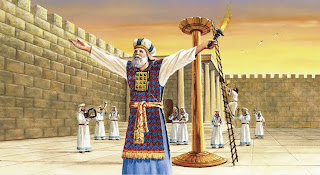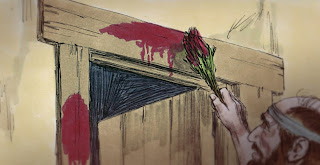The feast of tabernacles is mentioned several times in the Hebrew Scriptures (Ex. 23:16, 34:22&23, Num. 29:12, Deut. 16:13, 2 Chron. 8:12&13, Ezra 3:4, Neh. 8:17&18), however John 7 is the only reference found to it in the Greek Scriptures.
Can Christ’s words in John 7 and the surrounding chapters, help us understand the meaning and spiritual fulfilment of the final feast?
John 7
2 Now the Jews’ feast of tabernacles was at hand.
37 In the last day, that great day of the feast, Jesus stood and cried, saying, If any man thirst, let him come unto me, and drink.
38 He that believeth on me, as the Scripture hath said, out of his belly shall flow rivers of living water.
As a Jewish man, Jesus was expected to attend the feast of tabernacles. He would have been inside the temple, likely standing in the woman’s court as he witnessed the celebrations, then gave his speech.
What Jesus witnessed was not that described in Leviticus 23, the Jews had created their own traditions. However he used their traditions as a launching pad to get his message across.
For seven nights a priest went down to the pool of Siloam, filled a jug with water, then poured it upon the brazen alter. This was accompanied by a fan fare of music, singing and dancing.
On the last, great day of the feast, when the water ceremony and all the fan fare was over, Jesus stood and cried “if any man thirst let him come unto me and drink…living water”
LIVING WATER
“Living water” is that which flows from a natural source, as opposed to a stagnant pool of rain water.
The pool of Siloam, a Mikvah used for ceremonial cleansing, was fed by the Gihon Spring hence it contained “living water”.
According to John 4, “living water” represents “everlasting life” through the Spirit.
John 4
10 Jesus answered and said unto her, If thou knewest the gift of God, and who it is that saith to thee, Give me to drink; thou wouldest have asked of him, and he would have given thee living water.
14 But whosoever drinketh of the water that I shall give him shall never thirst; but the water that I shall give him shall be in him a well of water springing up into everlasting life.
A SPIRITUAL KINGDOM
We also know from John 4 that “everlasting life” pertains to a spiritual kingdom made up of “true worshippers” who worship God “in spirit and in truth”.
John 4
21 Jesus saith unto her, Woman, believe me, the hour cometh, when ye shall neither in this mountain, nor yet at Jerusalem, worship the Father.
23 But the hour cometh, and now is, when the true worshipers shall worship the Father in spirit and in truth:…
We can deduce from John 4 that this spiritual kingdom, would replace the physical temple in Jerusalem.
Jesus said “the hour comes and NOW is” when the Father shall be worshipped in Spirit, NOT in Jerusalem.
The word NOW suggests this spiritual kingdom was imminent.
SABBATH
The next thing I want to touch on in John 7 is the reference to sabbath.
The feast of tabernacles began and ended with a sabbath day.
Leviticus 23
34 …The fifteenth day of this seventh month shall be the feast of tabernacles for seven days…
35 On the first day shall be a holy convocation: ye shall do no servile work therein.
36 …on the eighth day shall be a holy convocation unto you…it is a solemn assembly; and ye shall do no servile work therein.
It’s no accident that on the last, great day, (a solemn, sabbath day) Jesus stood and cried “if any man thirst let him come unto me and drink…living water”.
In John 5 Jesus healed a lame man at the pool of Bethesda. This also happened on the sabbath.
John 5
8 Jesus saith unto him, Rise, take up thy bed, and walk.
9 And immediately the man was made whole, and took up his bed, and walked: and on the same day was the sabbath.
The pool of Bethesda consisted of an upper and lower basin. Unlike the pool of Siloam these were not fed by a natural spring, they contained rain water. However, water from the upper basin was sometimes released through a channel into the lower one, resembling “living water”.
When we connect John 5 to John 4 and John 7, we see a spiritual kingdom soon to replace the temple in Jerusalem, in which there is both everlasting life (living water) and sabbath rest.
But wait, there’s one more ingredient to this cake!
RESURRECTION
On the last, great day of the final feast Jesus stood and CRIED, he shouted, his voice was like a trumpet! What are trumpets often associated with in the bible? Resurrection!
If we look further down John 5, we find that the healing of the lame man pointed to a “resurrection” that would happen when the dead “hear the voice of the son of God”.
John 5
21 For as the Father raiseth up the dead, and quickeneth them; even so the Son -- quickeneth whom he will.
25 Verily, verily, I say unto you, The hour is coming, and now is, when the dead shall hear the voice of the Son of God: and they that hear shall live.
28 Marvel not at this: for the hour is coming, in the which all that are in the graves shall hear his voice,
29 And shall come forth; they that have done good, unto the resurrection of life; and they that have done evil, unto the resurrection of damnation.
If we look at other chapters surrounding John 7, we find repeated mention of a “last day” resurrection.
John 6
39 And this is the Father’s will which hath sent me, that of all which he hath given me I should lose nothing, but should raise it up again at the last day.
40 And this is the will of him that sent me, that every one which seeth the Son, and believeth on him, may have everlasting life: and I will raise him up at the last day.
John 11
23 Jesus saith unto her, Thy brother shall rise again.
24 Martha saith unto him, I know that he shall rise again in the resurrection at the last day.
25 Jesus said unto her, I am the resurrection, and the life: he that believeth in me, though he were dead, yet shall he live:
As I said, the feast of tabernacles was the seventh feast, celebrated in the seventh month for seven days and marked the end of the agricultural year thus was sometimes called the “feast of ingathering” (Ex. 23:16, 34:22).
The “resurrection at the last day” was the “ingathering” that the seventh feast/final harvest pointed to.
MEANING OF THE SEVENTH FEAST
As Jesus stood and cried in the temple on the last, great day of the final feast “if any man thirst, let him come unto me and drink….living water”, he was alluding to a last day “resurrection” in which “they that have done good” would be gathered into a spiritual kingdom to enjoy everlasting life and sabbath rest.
This spiritual kingdom is the New Jerusalem described in Revelation 21&22.
Revelation 22
1 And he showed me a pure river of water of life, clear as crystal, proceeding out of the throne of God and of the Lamb.
2 In the midst of the street of it, and on either side of the river, was there the tree of life…
17 And the Spirit and the bride say, Come. And let him that heareth say, Come. And let him that is athirst come. And whosoever will, let him take the water of life freely.
Here we see a crystal clear river flowing from the throne of God and of the lamb.
Jesus is the SOURCE of everlasting life and sabbath rest.
This was his message to the woman at the well, the lame man at the pool of Bethesda, those who were listening at the feast of tabernacles and it’s his message to you today.















